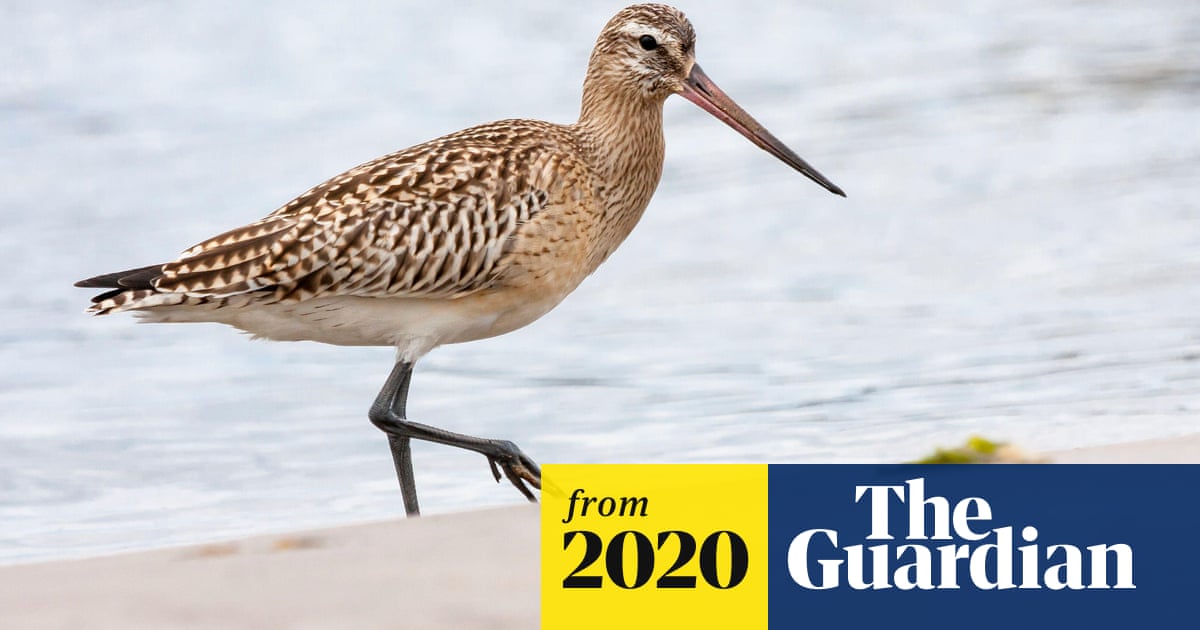'Jet fighter' godwit breaks world record for non-stop bird flight.
A bird said to have the aerodynamic build of a “jet fighter” has been tracked flying more than 12,000km (7,500 miles) from Alaska to New Zealand, setting a new world record for avian non-stop flight.
Announcement
Collapse
No announcement yet.
Godwits - On Path
Collapse
X
-
Re: Godwits - On Path
Godwits Return!
Christchurch ornithologists and park rangers expect the godwits' return from August. This year, the godwits are slightly later than usual, possibly because of unfavourable wind patterns in Alaska.
Video of Godwits feeding http://www.stuff.co.nz/environment/7...mmer-residency
Leave a comment:
-
Re: Godwits - On Path
The Godwits have arrived
Birdlife flocks to Estuary despite liquefaction fears
Christchurch City Council ranger and ornithologist Andrew Crossland said a bird survey he undertook a week after the quake showed there were 36,000 birds on the Estuary and the surrounding wetlands, including the city's wastewater oxidation ponds.
That was 5000 more birds than at the same time the previous year, he said.
..The arrival to the Estuary of bar-tailed godwits from Alaska, was marked yesterday by ringing the bells of St Paul's Anglican Church bells in Papanui. Christ Church Cathedral's bells had heralded the birds' arrival, but it was destroyed in February. http://www.stuff.co.nz/the-press/new...efaction-fears
Leave a comment:
-
Re: Godwits - On Path
Typed in except from The Press, Christchurch
David Hallett (photographer of the Godwits above) ... seagulls and ducks evident, but no wading birds. "The sand (from sand volcanoes during earthquakes) has killed off the food for waders. It's just smothered it, killing all snails and worms and things."
Avon-Heathcote Estuary Ihutai Trust Chairman Martin Maguire "What we have been told is that it will affect the future of feeding of wading birds in the estuary for sometime, but what we don't know is by how much. Those sand mounds have covered a lot of the wildlife that would have been food for all the wading birds"
Leave a comment:
-
Re: Godwits - On the Path of Bird Flu
Christchurch Cathedral bells rang out at noon to mark the end of the world's longest migration.
The first bar-tailed godwits to finish their more than 11,000km journey from Alaska have been spotted on Canterbury's Avon-Heathcote estuary.
Leave a comment:
-
Re: Godwits - On the Path of Bird Flu
David Hallett wins Qantas media awards in the Canon Photograph (senior) category for this photo of 7 Godwits flying in formation over Southshore Spit, Christchurch.

Leave a comment:
-
Re: Godwits - On the Path of Bird Flu
Thats mean GS! - there aren't enough to spare anyway! They are ALL precious!
Leave a comment:
-
Re: Godwits - On the Path of Bird Flu
experimentally infect a few godwits with flu and examine whether
they can spread it and transport it (over what distance ?)
to the sorrow of a few godwits for the benefit of all godwithood
(and other virus-suffering species)
do they get mallard-index-flu or (also) poultry-gull-mammal-flu ?
Leave a comment:
-
Re: Godwits - On the Path of Bird Flu
Farewell To The Godwits
Monday, 1 March 2010, 10:41 am
Press Release: Christchurch City Council <!--first blockquote gone!--> Farewell To The Godwits
Christchurch’s iconic global travellers, the Bar-tailed godwits, will have their annual send-off at 5.30pm on Wednesday.
The godwits, whose annual arrival is seen as the start of spring in Christchurch, hit the headlines in New Zealand and around the world in 2007 when one of the birds was tracked on a non-stop migration flight from Alaska to New Zealand, covering at least 11,680 km in just eight and a half days.
Christchurch has made the godwits its own by designating them the harbingers of spring, and ensuring a safe environment for them at the Avon-Heathcote Estuary and other estuarine flats in the area. Godwits can only feed when the flats are exposed at low tide and they need secure places to roost when the tide is full.
This year’s godwits farewell event will be on site at the Southshore Spit from 5.30pm on Wednesday 3 March (at the end of Rocking Horse Road - you can catch a Route 5 bus). Please no dogs. Council Rangers and members of the Ornithological Society will show visitors the godwits.
Christchurch City Council rangers have reported increasing numbers of godwits at the Avon-Heathcote Estuary, Brooklands Lagoon and the top end of Lyttelton Harbour, leading to the belief that the birds may have enjoyed good breeding success for the past few years.
Godwit numbers peaked at 2110 on the Avon-Heathcote Estuary in December 2009, taking the annual totals to over 2000 for each of the past three years after lower numbers between 1994 and 2007. Godwits numbers at the other coastal wetlands also showed increases - 459 on Upper Lyttelton Harbour and 97 at Brooklands lagoon.
Every year the Christ Church Cathedral bells peal for 30 minutes to announce the arrival of the visitors in September after their non-stop flight from Alaska and the Christchurch City Council rangers and the Avon-Heathcote Estuary Ihutai Trust puts together a farewell event at the time of their departure.
The scientific community, which deems godwits as a ‘Species of High Concern’, are anticipating a decline in numbers once coastal wetland reclamation projects and habitat destruction in Asia make an impact on the bird's survival during northward migration. The exact status of the bar-tailed godwit population worldwide is not known.
Farewell to the godwits
Southshore Spit
5.30pm
Wednesday 3 March
Leave a comment:
-
Re: Godwits - On the Path of Bird Flu
What flyway take a Godwit to Shanghai?
Godwit Banding at South Brighton Spit (edit Christchurch) WEDNESDAY 11th Nov ...There are about 1900 birds there, with one having a Chinese flag combo [Shanghai] and 2 having numbers in black on their orange flags, from victoria. Also one with a data-logger on her leg, which we are keen to catch, so it can be removed. http://www.birdsofchristchurch.co.nz/?p=1059
Leave a comment:
-
Re: Godwits - On the Path of Bird Flu
Amazing ..... that they have neough energy left to fly a perfect formation.
What a bird!
.
Leave a comment:
-
Re: Godwits - On the Path of Bird Flu

photo David Hallett. Formation Flying: Godwits put on a show as they come into land at Christchurchś Southshore Spit, after their 11.500 km journey from Alaska
Each year about 2000 Godwits migrate to Christchurch from Alaska
Energy savings
Birds have developed a variety of ways to reduce the amount of energy they need for flight. Some species fly in formation, which reduces expended energy by around 20%. Non-gliders can increase their speed by flying at altitudes of around 1,500 metres, in air that is less dense than at sea level. Many seabirds glide and use wind and wave pressure for ‘dynamic soaring’. This needs much less energy than flapping their wings. Soaring on rising thermals is possible for birds crossing hot continents, and many birds also make good use of tail winds to reduce the amount of energy and time.
Leave a comment:
-
Re: Godwits - On the Path of Bird Flu
Here's good map from NZ:
.
Leave a comment:


Leave a comment: